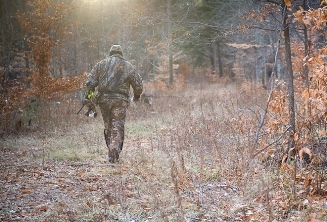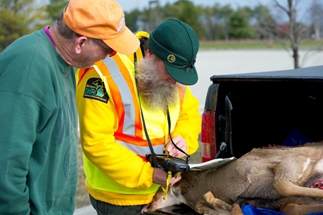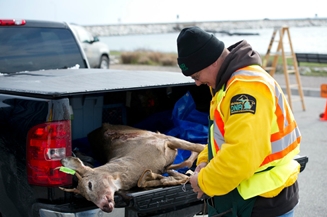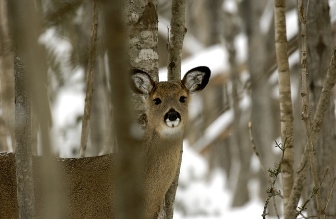DNR reports 2014 deer hunting harvest down across Michigan
Michigan Department of Natural Resources sent this bulletin at 07/22/2015 09:00 AM EDT|
Several factors added to decline; wildlife managers working on remedies. |
 |
 |
 |
Press Release
FOR IMMEDIATE RELEASE
July 22, 2015
Contact: Chad Stewart, 517-641-4903, ext. 263
DNR reports 2014 deer hunting harvest down across Michigan
Several factors added to decline; wildlife managers working on improvements The Michigan Department of Natural Resources recently issued a Michigan Deer Harvest Survey Report on the 2014 hunting seasons indicating that roughly 615,000 hunters statewide harvested a total of roughly 329,000 deer. The harvest represents a drop of 15 percent from 2013.
The Michigan Department of Natural Resources recently issued a Michigan Deer Harvest Survey Report on the 2014 hunting seasons indicating that roughly 615,000 hunters statewide harvested a total of roughly 329,000 deer. The harvest represents a drop of 15 percent from 2013.
Wildlife managers report that regional declines in deer harvest were greatest in the Upper Peninsula, where the overall harvest was down by nearly 36 percent.
The DNR said several factors – including back-to-back years of severe winter weather that depleted the deer population in some parts of the state – contributed to the decline.
Snow, snow and more snow
“In the Upper Peninsula, winter started early with more than 3 feet of snow on the ground in some areas before the Nov. 15 opening of firearm deer season,” said DNR wildlife biologist Brian Frawley. “Though not as severe as the previous season, this marked the third consecutive rough winter for the deer population in the U.P.”
Frawley said that much of the region’s drop in deer harvest can be explained by those conditions. The heavy U.P. snowfall, for example, made it challenging – sometimes impossible – for some firearm deer hunters to get to their camps. Given the conditions, many decided not to hunt; others, after experiencing the effects of the two previous winters, decided not to buy licenses.
“When the number of hunters is reduced in a given year, the deer harvest potential naturally is reduced, too,” Frawley said.
Across all hunting seasons, 84,099 people hunted deer in the U.P. in 2014, down about 19 percent from 2013.
Natural cyclical movement
DNR Director Keith Creagh said that like Michigan's deer population, the state’s deer harvest numbers have risen and fallen in an ebb-and-flow pattern since the early 1960s. "The number of deer harvested hit a low in the early 1970s at below 100,000 statewide," Creagh said. "With mild winters and changing forest conditions, deer populations then rose and hunter harvest climbed to more than 400,000 by the late 1980s."
"The number of deer harvested hit a low in the early 1970s at below 100,000 statewide," Creagh said. "With mild winters and changing forest conditions, deer populations then rose and hunter harvest climbed to more than 400,000 by the late 1980s."
After tough back-to-back winters in the mid-1990s, the harvest followed the population steeply downhill, but rebounded again to nearly 600,000 by the end of the decade. Since then, deer harvest has remained below 500,000 since the early 2000s.
Other population indicators
DNR deer program biologist Ashley Autenrieth said U.P. deer-vehicle collisions tallied 2,961, down 22 percent from 2013. Crop damage permit kills were down to 1,664 in 2014 from 1,745 the previous year.
"These two factors indicate a drop in the overall deer population," Autenrieth said.
The winter severity index, crop damage permits and deer-vehicle accidents also were down in the northern Lower Peninsula.
Pockets of success
In northern parts of the U.P., firearm deer hunters who did get to their camps and blinds found the snowy conditions had put many deer on southward seasonal migration paths early. Hunters who altered their strategies to follow those paths fared better.
Despite the challenging conditions, firearm deer hunters in the U.P. harvested 14,734 antlered bucks, with 41,415 taken in the northern Lower Peninsula and 49,110 in the southern Lower Peninsula.
Across all 2014 deer hunting seasons, nearly a fourth of hunters in the western U.P., and 14.6 percent in the eastern U.P., harvested at least one antlered buck. Statewide, the percentage jumped to 26.9 percent.
Overall deer harvest, hunter satisfaction Statewide, 41 percent of hunters harvested a deer in 2014, compared to 43 percent in 2013. Roughly 11 percent of deer hunters harvested two or more deer of any type. Less than 4 percent of hunters took two antlered bucks.
Statewide, 41 percent of hunters harvested a deer in 2014, compared to 43 percent in 2013. Roughly 11 percent of deer hunters harvested two or more deer of any type. Less than 4 percent of hunters took two antlered bucks.
About 20 percent of deer hunters harvested an antlerless deer and 27 percent took an antlered buck.
“Across Michigan, 39 percent of hunters said they were satisfied with their overall hunting experience, with the highest satisfaction in the Lower Peninsula,” Frawley said. “Those are numbers we want to build on as we work to provide a positive experience for hunters in every part of the state.”
Other population, harvest factors
Michigan deer hunters spent 8.8 million days afield last year. DNR efforts to improve the deer population affected the harvest numbers as well. Those actions include:
- To protect more does in the U.P., the Michigan Natural Resources Commission restricted the number of deer management units open to antlerless deer hunting to three areas in the southern part of the region.
- Recently, at the urging of hunters, the NRC decided to remove for this fall the ability of hunters in the U.P. to tag antlerless deer during the archery season with a single or combination deer license.
For the long-term, DNR and hunter efforts continue to improve deer habitat:
- A U.P. Habitat Workgroup reconvened in January, focused on improving and conserving critical winter deer habitat, offering technical assistance and incentives to private landowners.
- A Mississippi State University multiyear study on the role of predators, winter weather and habitat on white-tailed deer fawn survival in the U.P. is continuing, aided by the DNR and Safari Club International.
 Reasons for optimism
Reasons for optimism
Although the overall number of license buyers was down from 10 years ago, an increased number of people younger than 14 years old and people older than 50 bought a hunting license last year. Overall, 12 percent of license buyers were younger than 17 years old.
The DNR continues efforts to meet changing hunter demographics by promoting hunting to younger hunters and female hunters, whose numbers are rising.
Across Michigan, about 57 percent of hunters supported antler point restrictions on buck harvest that were implemented for the U.P. and about 63 percent of the hunters who preferred to hunt in the U.P. supported the antler point restrictions.
The DNR offered all deer hunters the option to voluntarily report information about their deer hunt via the Internet. More than 4,200 hunters responded. Next, a questionnaire was sent to 58,857 randomly selected individuals who had bought a hunting license, but had not reported harvest information online. Respondents who promptly responded became eligible to win a firearm or a bow.
Questionnaires were returned by 29,035 hunters (a 51-percent response rate), providing additional valuable harvest and experience data.
Moving forward, the DNR and the NRC will continue to talk with the public regarding their ideas on more measures that potentially could be taken to further improve deer hunting in Michigan.
For more information on the 2014 deer harvest report, visit www.michigan.gov/deer.
/Note to editors: Accompanying photos are available below for download. Suggested captions follow.
Archer -- Michigan deer hunters spent 8.8 million days afield last year.
Check Station -- A Michigan Department of Natural Resources employee inspects a deer at a check station during the 2014 season.
Check Station-2 -- Same as above.
Deer -- Several factors contributed to a lower deer hunting harvest in 2014./